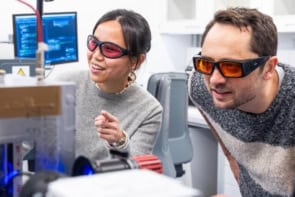
The first-ever sonic tractor beam that can levitate objects larger than half the wavelength of the ultrasound used has been created by researchers at the University of Bristol, in the UK. The new technique involves creating a “virtual vortex” of ultrasound that can be adjusted, while maintaining the trapping force. This reduces the destabilizing forces that perturb larger objects, enabling such particles to be held. The researchers say that the new technique also allows smaller objects to be moved using a much wider range of ultrasound frequencies, opening up medical applications such as moving kidney stones.
In 2015, Bristol’s Asier Marzo and Bruce Drinkwater developed a sonic tractor beam that used ultrasound to levitate, rotate and move objects in multiple directions. That device used a grid of 64 off-the-shelf, miniature loudspeakers controlled by a programmable array of transducers to create acoustic holograms that could trap and manipulate objects in mid-air. The researchers created three different acoustic shapes – tweezers, a vortex that traps objects at its core, and a cage. Using these they were able to levitate and control polystyrene particles ranging with diameters of 0.6-3.1 mm.
Most sonic tractor beams have a fundamental limitation that they can only levitate particles smaller than half the wavelength of the ultrasound used. This is because the particles sit in the areas of low intensity – or low amplitude – in the acoustic field, which are half-a-wavelength long. Larger particles occupy areas of high and low intensity and become unstable.
Circling wildly
Vortices work differently. The particles sit rotating in the core of the vortex – a powerful potential well – surrounded by the circular flow. But this central trap is narrow and large particles get caught by the revolving flow. They then circle wildly with increasing speed until they are ejected. In this latest research, Marzo, Drinkwater and Mihai Caleap, confirmed this by showing that a vortex created by an array of 52 loudspeakers operating at 40 kHz with a wavelength of almost 9 mm cannot hold particles larger than 1.6 mm.
Reducing the rotational speed of the vortex would reduce these instabilities, allowing larger particles to be held, but it cannot be controlled independently of the trapping force. Both are proportional to the power of the beam. “You can reduce the power, but at some point the particle will drop,” explains Marzo.
Undeterred, the team increased the number of loudspeakers to 192 – again operating at 40 kHz with a wavelength of almost 9 mm – to create a virtual vortex that alternates rapidly between two vortices of equal speed but rotating in opposite directions. By adjusting the properties of these switching vortices they were able to tune the speed of the virtual vortex independently of the trapping force. This stopped the levitating particle from orbiting, making it much more stable.
Averaging out
“Instead of emitting one vortex continuously we pulse, we emit one vortex 1 ms going counter-clockwise and then 1 ms later we emit the same vortex but going clockwise,” Marzo told Physics World. “Basically, we are zigzagging the directions of the vortices and we do it really, really fast so that the particle doesn’t have time to react to either of the individual vortices, it reacts to the averages.”
Using this technique, they successfully trapped 10 mm and 16 mm diameter particles – approximately 1.2 and 1.9 wavelengths, respectively. They also tilted the tractor beam past 90° with the 10 mm particle, demonstrating that the object is trapped by the ultrasound, not just levitated against gravity.
Marzo says that although removing the half wavelength limit has opened up the possibility of controlling large objects with ultrasound, especially in situations where you don’t have to work against gravity, such as on the International Space Station. “Everyone always likes to go larger and say could we levitate humans, but I see the real applications as going smaller, like manipulating things that are inside your body,” he says.
Moving kidney stones
He explains that possible applications include trapping and moving kidney stones with medical imaging machines. Previously this wasn’t possible due to the very small wavelengths they use to capture high resolution images. “Now, because we can trap particles larger than half a wavelength, you could use the same machine that is used for imaging for trapping particles,” Marzo says.
The new trapping technology is described in Physical Review Letters



